当前位置:网站首页>string(讲解)
string(讲解)
2022-07-07 01:45:00 【韩悬子】
目录
1.标准库里面的string类了解
- string是表示字符串的字符串类
- 该类的接口与常规容器的接口基本相同,再添加了一些专门用来操作string的常规操作。
- string在底层实际是:basic_string模板类的别名,typedefbasic_string<char, char_traits, allocator>string;(报错是basic_string不用太注意)
- 不能操作多字节或者变长字符的序列。在使用string类时,必须包含#include头文件以及using namespace std;
2.sting常用的构造函数用法
#include<string>
//管理动态增长的字符数组,以\0为结尾
int main()
{
string s1;
return 0;
}
这个是最常用的,作用是管理动态增长的字符数组,以\0为结尾。
但是注意这里是不能编译成功的
因为在使用string类时,必须包含#include头文件以及using namespace std;(因为c++标准库都是存放在std里面的)
如果不包std,可以按下面用法
代码
#include<string>
//管理动态增长的字符数组,以\0为结尾
int main()
{
std::string s1;
return 0;
}
不过当然啦,这里我们为了使用方便我们就把std全部展开
string还有一种写法,就是
#include<iostream>
using namespace std;
#include<string>
//管理动态增长的字符数组,以\0为结尾
int main()
{
string s1;
string s2("hello world");
return 0;
}
这种就是用常量字符串来初始化,这个使用new或者malloc出来的,然后就把这个数组拷贝过去,这种有个最大的优点就是它这个是动态增长的,你搞个数组它的大小是定死的,但是string的这个可以动态增长,原理也很简单,因为是扩容
用法
#include<iostream>
using namespace std;
#include<string>
//管理动态增长的字符数组,以\0为结尾
int main()
{
string s1;
string s2("hello world");
s2 += "!!!!!";
cout<<s2<<endl;
return 0;
}
打印结果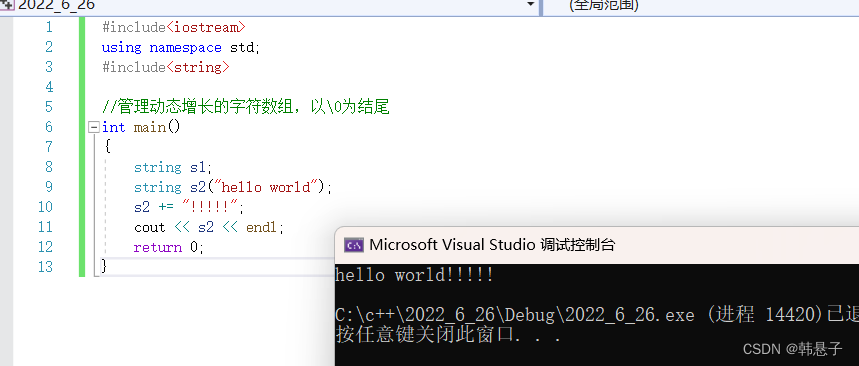
不过当然除了这种还有一种拷贝构造
代码
#include<iostream>
using namespace std;
#include<string>
//管理动态增长的字符数组,以\0为结尾
int main()
{
string s1;
string s2("hello world");
s2 += "!!!!!";
cout << s2 << endl;
string s3(s2);
string s4 = s2;
return 0;
}
只要拿一个以存在的对象,去初始化一个未存在的对象,这个都是拷贝构造
还有一种写法,就是想要用这个字符串前n个来初始化,后面的不要
代码
#include<iostream>
using namespace std;
#include<string>
//管理动态增长的字符数组,以\0为结尾
int main()
{
string s1;
string s2("hello world");
s2 += "!!!!!";
cout << s2 << endl;
string s3(s2);
string s4 = s2;
string s5("https://editor.csdn.net/md?articleId=125475746", 4);
cout << s5 << endl;
return 0;
}
运行结果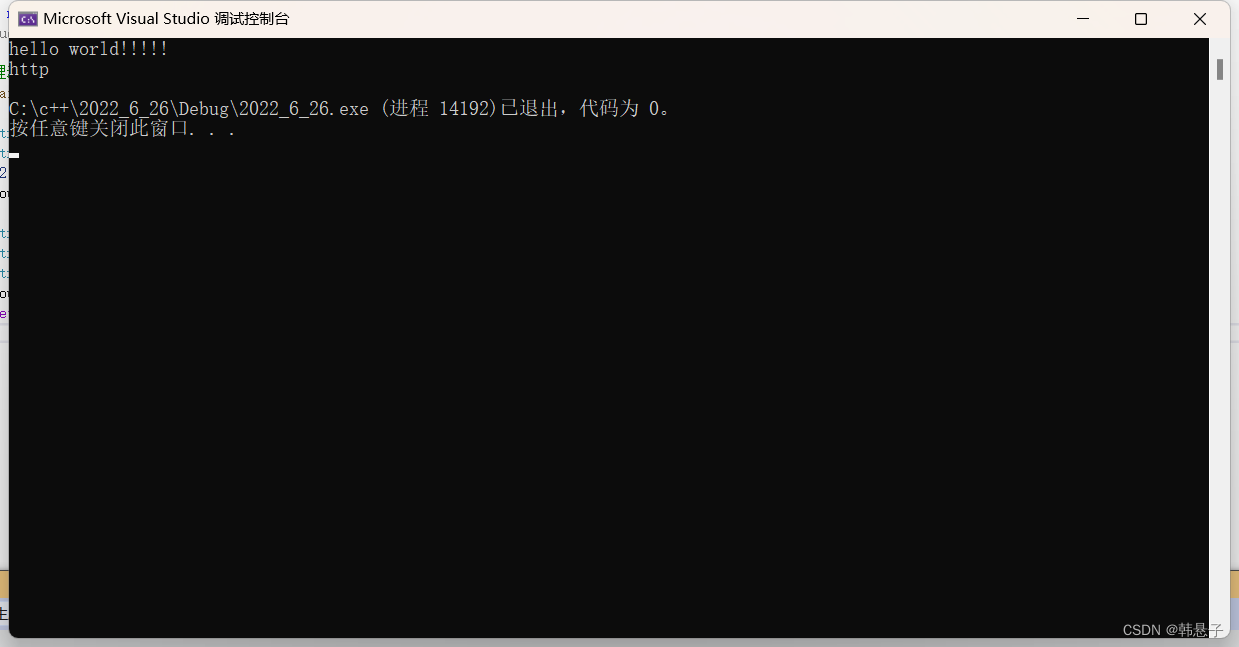
还有一种是从某个字符串n位置做起始,拷贝n个字符
代码
#include<iostream>
using namespace std;
#include<string>
//管理动态增长的字符数组,以\0为结尾
int main()
{
string s1;
string s2("hello world");
s2 += "!!!!!";
cout << s2 << endl;
string s3(s2);
string s4 = s2;
string s5("https://editor.csdn.net/md?articleId=125475746", 4);
cout << s5 << endl;
string s6(s2, 5, 6);
cout << s6 << endl;
return 0;
}
运行结果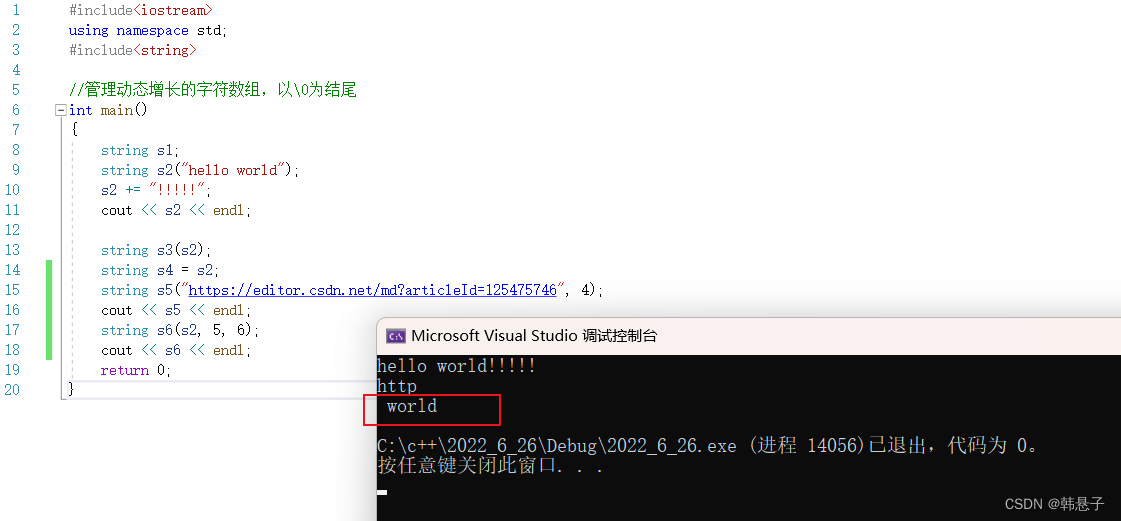
不过这里如果我只要了6个,要是我要100个会报错吗?
答案是不会,超过字符串大小会是有多少给多少
3.string小练习
我们把string的用法讲的差不多了我们来做下题吧
题链接
题描述
给你一个字符串 s ,根据下述规则反转字符串:
所有非英文字母保留在原有位置。
所有英文字母(小写或大写)位置反转。
返回反转后的 s 。
不过当然想做这道题最主要的是会遍历字符串
前面没讲string的遍历方式
第一种遍历方式的代码
1.下标+[]
void test2()
{
string s1("hello");
cout << s1.size() << endl;//这个是不包含\0的
//第一种方式 下标+[]
for (size_t i = 0; i < s1.size(); i++)
{
//s1.operator[](i);
cout << s1[i] << " ";
}
cout << endl;
}
这个要注意的是这里的size是不包含\0的所以打印是5个,还有遍历方式也是不同这个不是数组,这个相当于调用函数,相当于调用s1.operator;
运行结果
第二种遍历方式
2.迭代器
void test3()
{
string s1("hello");
//迭代器
string::iterator it=s1.begin();
while (it != s1.end())
{
cout << *it << " ";
++it;
}
cout << endl;
}
这种是迭代器遍历,迭代器是像指针一样的东西或者就是指针,s1.begjn()是代表着起始的位置,而end()是代表着结束的下个位置,其实就是左闭右开。
这里还有一个问题就是能不能把it != s1.begin()改成it < s1.begin(), 在1某些情况可以,比如它们空间是连续的,但是不推荐<的这种写法,因为你的内存不一定是连续的,一旦不是连续的你就会出现错误了
运行结果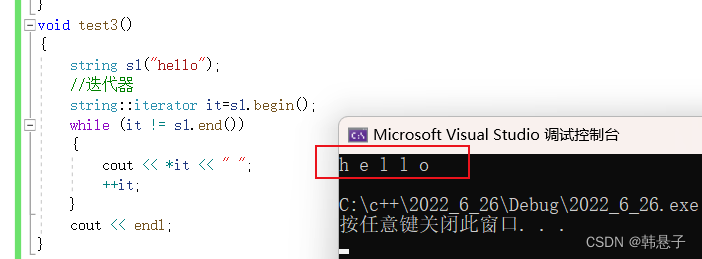
第三种遍历方式
void test4()
{
string s1("hello");
for (auto ch : s1)
{
cout << ch << " ";
}
}
3.范围for
原理很简单,其实底层原理就是替换成迭代器
运行结果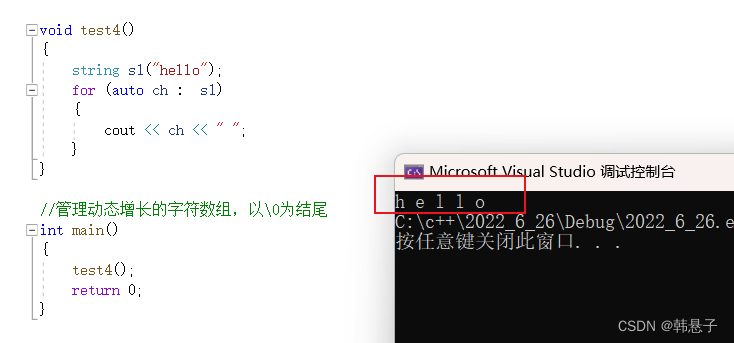
题目答案
下标+[]的写法
class Solution {
public:
bool isLetter(char ch)
{
//只要是26位字母就返回真
if( ch >='a' && ch<='z')
return true;
else if(ch>='A' && ch<='Z')
return true;
else
return false;
}
string reverseOnlyLetters(string s) {
int left=0,right=s.size()-1;
while(left<right)
{
//是26位字母就不动,直接交换,如果不是就按要求加加减减
while(left<right && !isLetter(s[left]))
++left;
while(left<right && !isLetter(s[right]))
--right;
swap(s[left],s[right]);
++left;
--right;
}
return s;
}
};
迭代器的写法
代码
class Solution {
public:
bool isLetter(char ch)
{
if( ch >='a' && ch<='z')
return true;
else if(ch>='A' && ch<='Z')
return true;
else
return false;
}
string reverseOnlyLetters(string s) {
string::iterator leftit=s.begin();
string::iterator rightit=s.end()-1;
while(leftit<rightit)
{
while(leftit<rightit && !isLetter(*leftit))
++leftit;
while(leftit<rightit && !isLetter(*rightit))
--rightit;
swap(*leftit,*rightit);
++leftit;
--rightit;
}
return s;
}
};
4.迭代器
1.正向迭代器
这个很简单的就是前面讲遍历字符串的那个迭代器就是正向迭代器
代码
void test3()
{
string s1("hello");
//迭代器
string::iterator it=s1.begin();
while (it != s1.end())
{
cout << *it << " ";
++it;
}
cout << endl;
}
2.反向迭代器
这个和名字相同,正向遍历是从前面遍历,那么反向遍历就是从后面开始遍历的
代码
void test5()
{
string s1("hello");
string::reverse_iterator rit = s1.rbegin();
while (rit!=s1.rend())
{
cout << *rit << " ";
++rit;
}
cout << endl;;
}
运行结果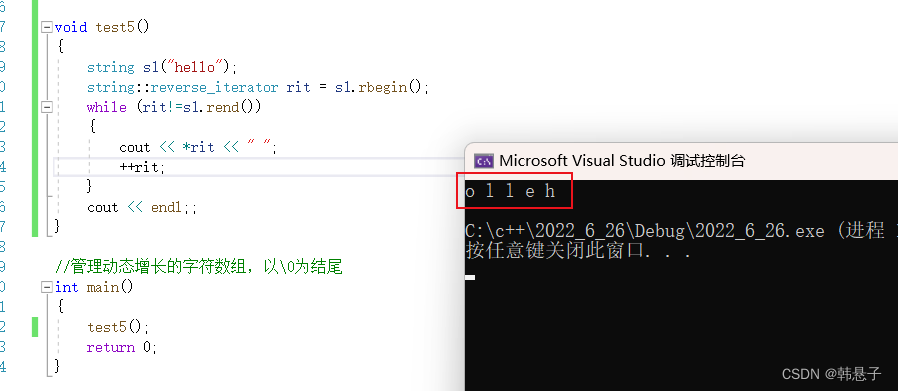
3.加了const的迭代器
代码
void test3()
{
string s1("hello");
//迭代器
string::iterator it = s1.begin();
while (it != s1.end())
{
(*it) += 1;
cout << *it << " ";
++it;
}
cout << endl;
it = s1.begin();
while (it != s1.end())
{
(*it) -= 1;
cout << *it << " ";
++it;
}
cout << endl;
}
//管理动态增长的字符数组,以\0为结尾
int main()
{
test3();
return 0;
}
因为迭代器是像指针一样的东西或者就是指针,所以他可以可读可写
下面是运行结果,上面代码的意思是让hello每一位-1,然后通过加1来变回hello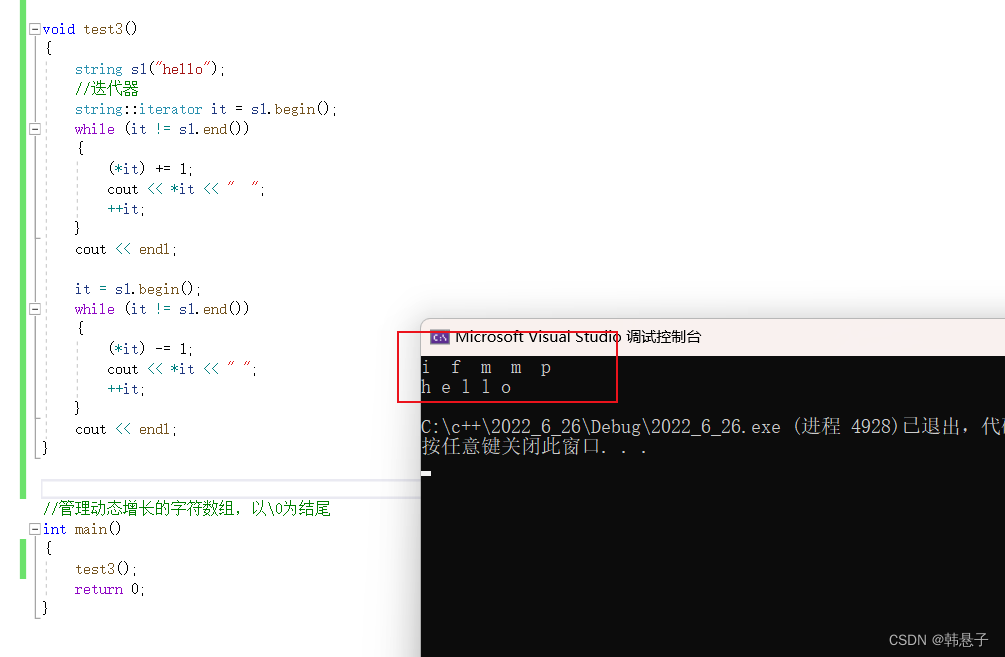
所以这里正常的版本,有了这个版本也有const的版本了
const的版本就只能只能可读了,不能可写了
代码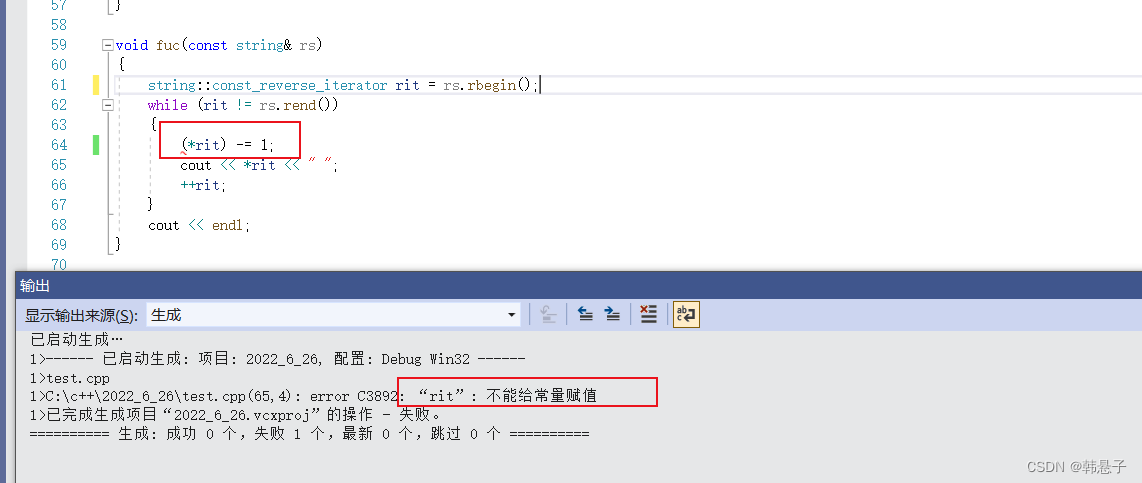
可以看到其实迭代器不只是二种其实是四种,正向迭代器,const正向迭代器,反向迭代器,const反向迭代器
不过当然有人可能觉得迭代器太麻烦了要打那么多代码,这时候有个好办法
那就是auto
代码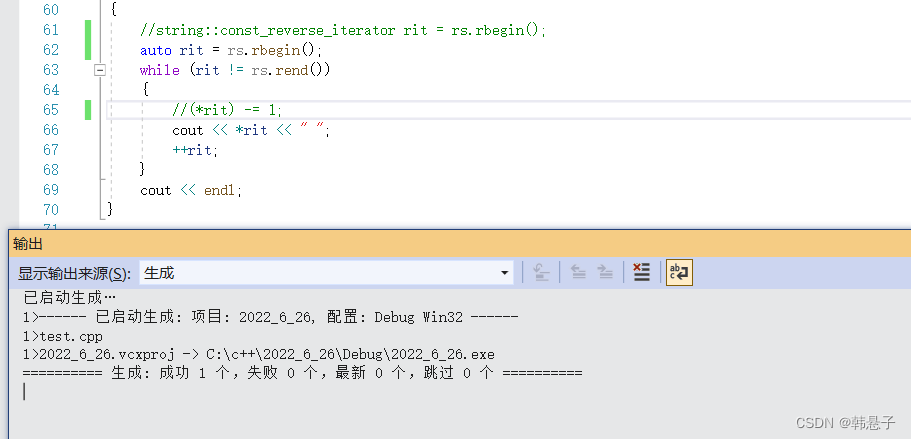
5.string的swap和库里面的swap的区别
代码
#include<iostream>
using namespace std;
void test1()
{
string s1("hello world");
string s2("hello");
s1.swap(s2);
swap(s1, s2);
}
int main()
{
test1();
return 0;
}
请问它们的区别是什么
s1.swap(s2);的效率高因为它是交换二个的指针
swap(s1, s2);的效率因为它是深拷贝
边栏推荐
- The solution of a simple algebraic problem
- 【OpenCV】形态学滤波(2):开运算、形态学梯度、顶帽、黑帽
- 693. 行程排序
- Rk3399 platform development series explanation (WiFi) 5.52. Introduction to WiFi framework composition
- Check point: the core element for enterprises to deploy zero trust network (ztna)
- 3428. 放苹果
- Jstat of JVM command: View JVM statistics
- [SOC FPGA] custom IP PWM breathing lamp
- Three updates to build applications for different types of devices | 2022 i/o key review
- 微信小程序隐藏video标签的进度条组件
猜你喜欢
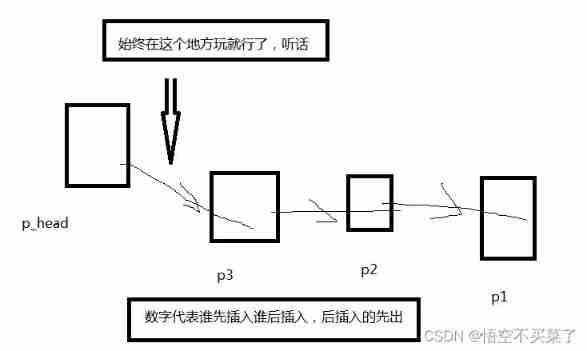
Chain storage of stack
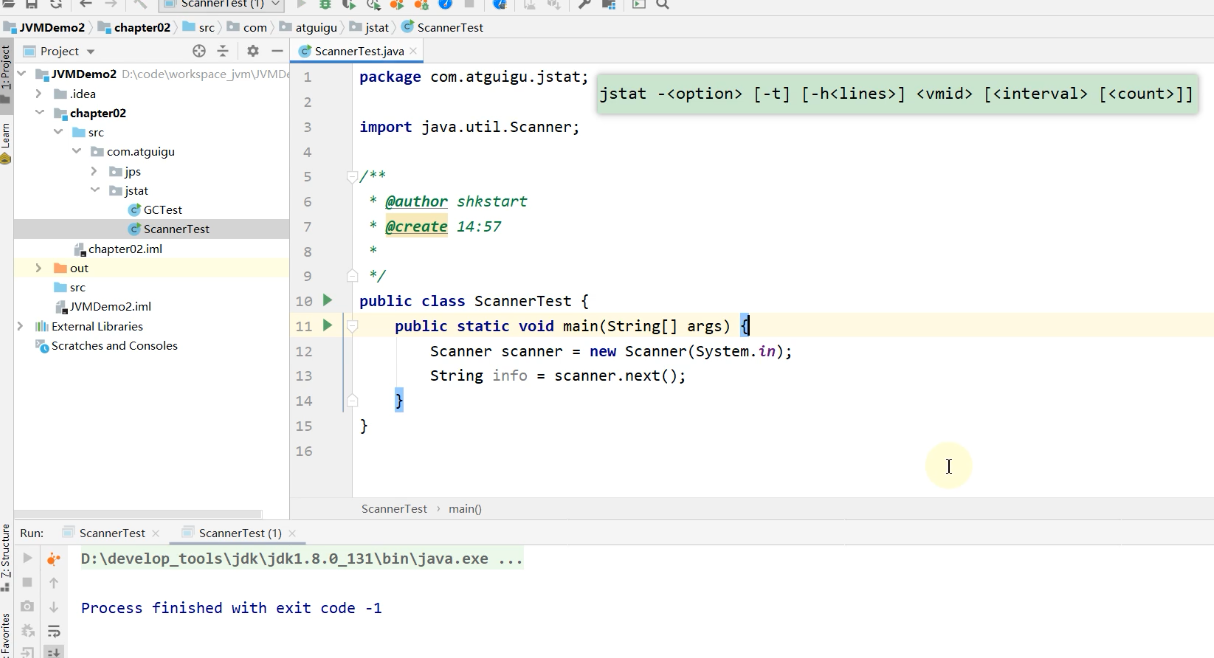
Jstat pour la commande JVM: voir les statistiques JVM

Introduction to yarn (one article is enough)
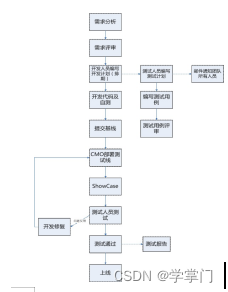
Several key steps of software testing, you need to know

博士申请 | 上海交通大学自然科学研究院洪亮教授招收深度学习方向博士生
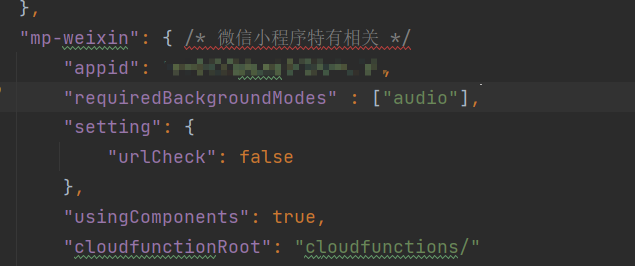
uniapp开发小程序如何使用微信云托管或云函数进行云开发
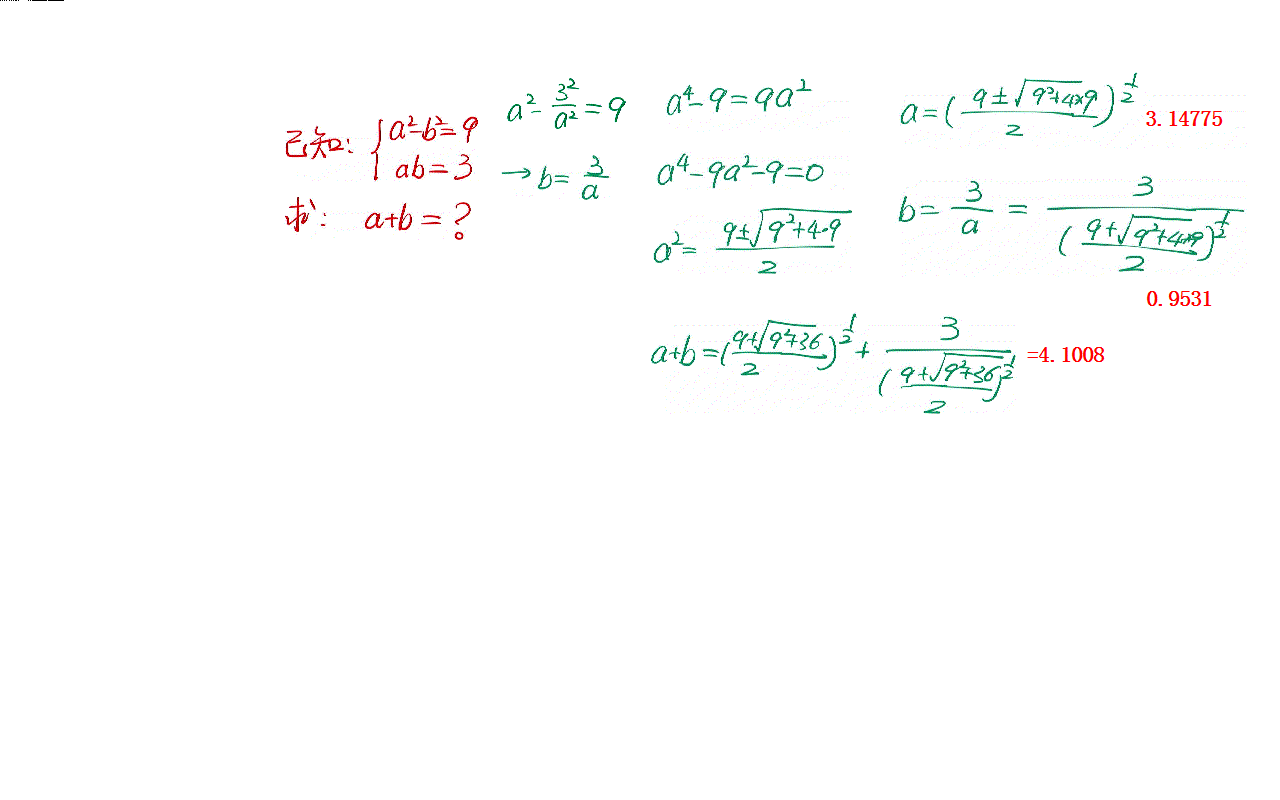
The solution of a simple algebraic problem

Ctfshow-- common posture
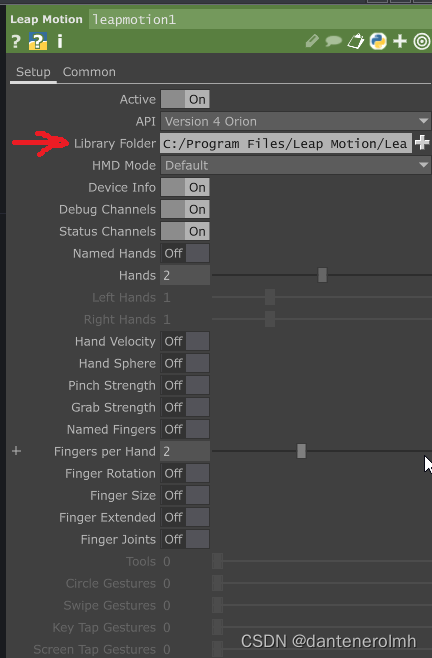
How to set up in touch designer 2022 to solve the problem that leap motion is not recognized?
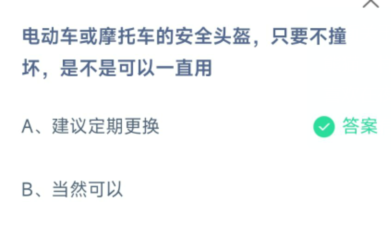
蚂蚁庄园安全头盔 7.8蚂蚁庄园答案
随机推荐
Say sqlyog deceived me!
Symmetric binary tree [tree traversal]
vim映射大K
FlexRay通信协议概述
[FPGA tutorial case 13] design and implementation of CIC filter based on vivado core
VMware安装后打开就蓝屏
【GNN】图解GNN: A gentle introduction(含视频)
你不知道的互联网公司招聘黑话大全
How to set up in touch designer 2022 to solve the problem that leap motion is not recognized?
JVM命令之 jstat:查看JVM統計信息
蚂蚁庄园安全头盔 7.8蚂蚁庄园答案
Deep clustering: joint optimization of depth representation learning and clustering
POI excel export, one of my template methods
JVM命令之- jmap:导出内存映像文件&内存使用情况
360 Zhiyu released 7.0 new products to create an exclusive "unified digital workspace" for the party, government and army, and central and state-owned enterprises
On the discrimination of "fake death" state of STC single chip microcomputer
uniapp开发小程序如何使用微信云托管或云函数进行云开发
为不同类型设备构建应用的三大更新 | 2022 I/O 重点回顾
Qt多线程的多种方法之一 QThread
软件测试的几个关键步骤,你需要知道